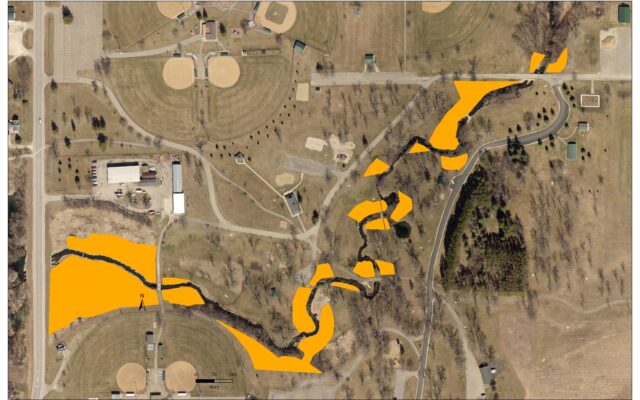Mower SWCD, Austin Parks and Rec Department planting native grasses and flowers at Austin Park

Grassy areas along the trout stream in Austin’s Todd Park should turn brown in the coming weeks but there’s no reason for concern.
Nearly five acres overall of mostly lawn grass are getting sprayed by herbicide this week to kill the vegetation in preparation for seeding those scattered sites along Wolf Creek for native grasses and flowers.
The project, funded by a $2,000 grant from the Austin Area Foundation, will help protect pollutants from reaching the stream while adding wildlife habitat, including for endangered pollinators, and enhancing the park’s natural beauty.
It will take time, however, for these areas to establish their full color and beauty, said James Fett, a watershed technician for Mower Soil & Water Conservation District leading the project.
Planting plans fairly evenly target both sides of Wolf Creek, which has nearly 9,000 feet of public shoreline in Todd Park.
Mower SWCD has worked closely with the Austin Parks, Recreation & Forestry Department along with the A.T.A.R.I. local disc golf club and Minnesota Department of Natural Resources, which worked with Fett to start a trout fishery in 2020 in Wolf.
Austin Parks & Recreation director Dave Merrill said his department is proud to participate in these types of projects that benefit prairie restoration, fish and wildlife.
Establishing native prairie can be a complicated and lengthy process but the results are worth it, Fett said.
Pink flags placed by Mower SWCD in the park mark the boundaries of what will be planted for native prairie and flowers. Oats will be included in the seed mix to help establish a temporary, vegetative cover that reduces the chances for erosion during the rest of the 2023 growing season. If necessary, Parks & Rec will mow to suppress unwanted weeds.
Many seeds will start germinating in summer 2024, Fett said, but these planted sites will look weedy while the plants are establishing their roots.
By 2025, many of the sites’ native flowers will start to bloom that spring and summer, Fett said; from that point, the flowers will get even better and continue to grow for many years.
This project stems from a recommendation in 2020 by Craig Soupier, the DNR’s area fisheries supervisor in Waterville. Soupir has led the annual spring stocking of trout in Wolf Creek since 2020, typically involving about 600 rainbows each year.
Austin Parks & Rec worked with Fett to develop a plan for site preparation and seeding, including the first step of applying herbicide to kill existing grasses and weeds. Once those are terminated, the sites along Wolf Creek will be tilled to tear up the thick mat and root masses that could lead to lawn grasses coming back to life.
The sites then will be left as bare soil for a couple of weeks to see if grasses or weeds grow back. If needed, Parks & Rec will apply a second round of herbicide to control unwanted vegetation.
Once the sites are ready, Mower SWCD will plant native seeds on top of the bare soil. Parks & Rec then will drag those spots to incorporate the seed into the soil.
These areas will be seeded with a deluxe native prairie mixture consisting of native grass species along with many native flower species that benefit pollinator insects, including some threatened and endangered.
Mower SWCD has worked closely with the Austin disc golf club to ensure the prairie doesn’t interfere with Todd Park’s extensive disc-golf course, which includes baskets along the creek.
Wolf Creek is the only Mower County stream stocked by the DNR for trout.
Since 2020, the DNR has done two stockings each spring – one in April and another in early May – of rainbow trout in Todd Park. Rainbows are a catchable size, making them ideal for the DNR’s goal of a “put-and-take” fishery for Wolf Creek. They are too large for predator fish to eat, reserving them only for anglers.
The fishery came about from Fett making a proposal in 2019 for the DNR to start stocking trout in Wolf Creek after he measured the stream’s temperature for two years. Fett also has led efforts to enroll and convert about 205 acres of cropland into permanent prairie and wetlands immediately upstream from Todd Park since the inception of the trout fishery.







